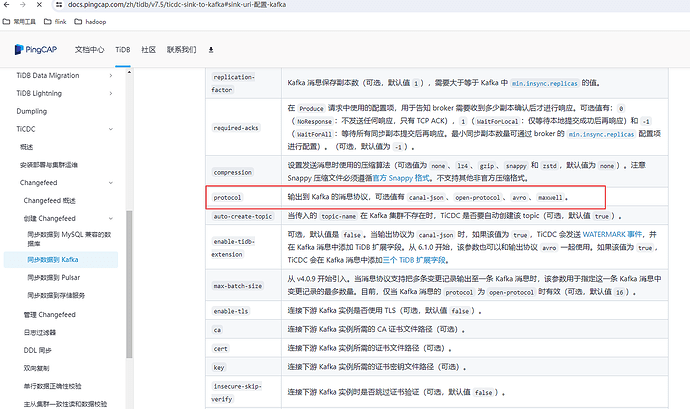Note:
This topic has been translated from a Chinese forum by GPT and might contain errors.Original topic: tidb cdc 同步数据异常
[TiDB Usage Environment] Test
[TiDB Version] v7.5.1
[Reproduction Path] Merging multiple data entries together
[Encountered Issue: Problem Phenomenon and Impact]
Table creation statement:
CREATE TABLE ods.`ods_test` (
`id` int(11) NOT NULL,
`user_id` int(11) DEFAULT NULL COMMENT 'User ID',
`user_name` varchar(48) COLLATE utf8mb4_general_ci DEFAULT NULL COMMENT '',
`mysql_delete_type` int(11) NOT NULL DEFAULT '0' COMMENT 'MySQL data type',
PRIMARY KEY (`id`) /*T![clustered_index] CLUSTERED */
) ENGINE=InnoDB DEFAULT CHARSET=utf8mb4 COLLATE=utf8mb4_general_ci COMMENT='';
Creating CDC:
case-sensitive = true
[filter]
rules = ['!*.*', 'ods.*']
[mounter]
worker-num = 16
[sink]
dispatchers = [
{matcher = ['*.*'], dispatcher = "table"}
]
protocol = "maxwell"
Executing SQL:
INSERT INTO ods.ods_test
(id, user_id, user_name, mysql_delete_type)
VALUES(1, 10749, '111', 0);
Kafka displays data:
{
"database": "ods",
"table": "ods_test",
"type": "insert",
"ts": 1719833732,
"data": {
"id": 1,
"mysql_delete_type": 0,
"user_id": 10749,
"user_name": "111"
}
}
Executing SQL again:
INSERT INTO ods.ods_test
(id, user_id, user_name, mysql_delete_type)
VALUES(4, 10596, '555', 0);
INSERT INTO ods.ods_test
(id, user_id, user_name, mysql_delete_type)
VALUES(5, 10749, '666', 0);
INSERT INTO ods.ods_test
(id, user_id, user_name, mysql_delete_type)
VALUES(6, 10596, '777', 0);
INSERT INTO ods.ods_test
(id, user_id, user_name, mysql_delete_type)
VALUES(7, 10749, '888', 0);
INSERT INTO ods.ods_test
(id, user_id, user_name, mysql_delete_type)
VALUES(8, 10596, '999', 0);
INSERT INTO ods.ods_test
(id, user_id, user_name, mysql_delete_type)
VALUES(9, 10749, '000', 0);
INSERT INTO ods.ods_test
(id, user_id, user_name, mysql_delete_type)
VALUES(10, 10596, '111', 0);
Kafka displays data:
First entry:
{
"database": "ods",
"table": "ods_test",
"type": "insert",
"ts": 1719833912,
"data": {
"id": 4,
"mysql_delete_type": 0,
"user_id": 10596,
"user_name": "555"
}
}
Second entry:
{"database":"ods","table":"ods_test","type":"insert","ts":1719833912,"data":{"id":5,"mysql_delete_type":0,"user_id":10749,"user_name":"666"}}
{"database":"ods","table":"ods_test","type":"insert","ts":1719833912,"data":{"id":6,"mysql_delete_type":0,"user_id":10596,"user_name":"777"}}
{"database":"ods","table":"ods_test","type":"insert","ts":1719833912,"data":{"id":7,"mysql_delete_type":0,"user_id":10749,"user_name":"888"}}
{"database":"ods","table":"ods_test","type":"insert","ts":1719833912,"data":{"id":8,"mysql_delete_type":0,"user_id":10596,"user_name":"999"}}
{"database":"ods","table":"ods_test","type":"insert","ts":1719833912,"data":{"id":9,"mysql_delete_type":0,"user_id":10749,"user_name":"000"}}
{"database":"ods","table":"ods_test","type":"insert","ts":1719833912,"data":{"id":10,"mysql_delete_type":0,"user_id":10596,"user_name":"111"}}
Change: dispatch = “ts”, clear table data,
Executing SQL:
INSERT INTO ods.ods_test
(id, user_id, user_name, mysql_delete_type)
VALUES(2, 10596, '222', 0),
(3, 10749, '333', 0),
(4, 10596, '555', 0);
Kafka data (still merged together):
{"database":"ods","table":"ods_test","type":"insert","ts":1719884437,"data":{"id":2,"mysql_delete_type":0,"user_id":10596,"user_name":"222"}}
{"database":"ods","table":"ods_test","type":"insert","ts":1719884437,"data":{"id":3,"mysql_delete_type":0,"user_id":10749,"user_name":"333"}}
{"database":"ods","table":"ods_test","type":"insert","ts":1719884437,"data":{"id":4,"mysql_delete_type":0,"user_id":10596,"user_name":"555"}}
